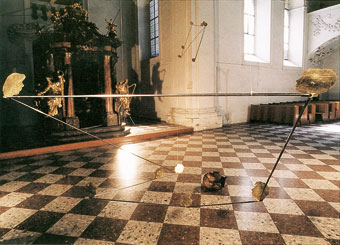
|
Egocentric Universe
1990/1992
Twelve-part room installation consisting of stellar constellations “hovering” in the room, with a total of sixty-six “stars” and a head sculpture lying on the ground.
Constellations: 11 pieces; wire rods, sheet brass; variable dimensions. Sculpture: bronzed plaster; life-sized. Total size: variable.
Eleven well-known constellations are installed in the form of mobiles (Sculptor, Libra, Corona Borealis, Cancer, Crater ...). The individual stars are sheet brass silhouettes of the artist’s relatives, friends and acquaintances. Wire rods replace the imaginary lines connecting the stars, thus displaying the constellation. On the floor is a bronzed plaster head of the artist done by a friend. Only from this perspective – as a metaphor for orientation based on images of society and the world – do we recognise the constellations. The title of the work alludes to a quotation by Claude Levi-Strauss.
Egocentric Universe | Mausoleum of Emperor Ferdinand II, Graz | March 19 – October 22, 1995 | solo exhibition | catalog.
|
Egozentrisches Universum
1990/1992
Zwölfteilige Rauminstallation, bestehend aus im Raum „schwebenden“ Sternbildern mit insgesamt 66 „Sternen“ und einer am Boden liegenden Kopf-Plastik.
Sternbilder: 11 Stück; Stangendraht, Messingblech; Maße variabel. Plastik: Gips bronziert; lebensgroß. Gesamtmaß: variabel.
Im Raum sind 11 der bekannten Sternbilder (Sculptor, Libra, Corona Borealis, Cancer, Crater ...) mobileartig installiert. Die einzelnen Sterne sind aus Messingblech gearbeitete Schattenrisse der Verwandten, FreundInnen und Bekannten des Künstlers. Stangendraht ersetzt die gedachten Verbindungslinien zwischen den Sternen, die das Sternbild deutlich machen. Am Boden liegt der von einem Freund angefertigte, bronzierte Gips-Kopf des Künstlers. Erst aus seiner Perspektive – als Metapher für die Orientierung an Gesellschafts- und Welt-Bildern – sind die Sternformationen erkennbar. Der Titel der Arbeit bezieht sich auf ein Zitat von Claude Levi-Strauss.
Egozentrisches Universum | Mausoleum Kaiser Ferdinands II., Graz | 19. März bis 22. Oktober 1995 | Einzelausstellung | Katalog.
|
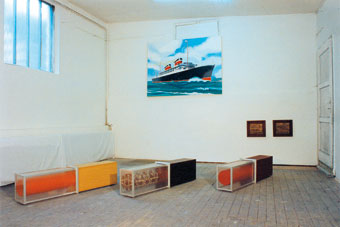
|
Home Torpedoes
1990/1991
Six-part room installation consisting of two reliefs, one picture, and three objects.
Reliefs: bronzed plaster, 32 x 36 cm each. Picture: acrylic on plywood, 120 x 160 cm. Objects: decorative panels, panel glass, aluminium extrusions, photocopies, mirrors, textiles; three pieces, 130 x 22 x 30 cm each. Total size: variable.
On one side the objects are made of various decorative panels, the “torpedoes” housed in transparent panel glass are covered with variously patterned and monochrome materials. The picture of the luxury liner at sea and the reliefs of submarines, steamers and other ships to the right below demarcate a space for “carpet torpedoes” in the private structure.
|
Hometorpedos
1990/1991
Sechsteilige Rauminstallation aus zwei Reliefs, einem Bild und drei Objekten.
Reliefs: Gips bronziert, je 32 x 36 cm. Bild: Acryl auf Sperrholz, 120 x 160 cm. Objekte: Dekorplatten, Paneelglas, Aluprofile, Fotokopien, Spiegel, Textilien; drei Stück, je 130 x 22 x 30 cm. Gesamtmaß: variabel.
Die Objekte sind halbseitig aus verschiedenfarbigen Dekorplatten gearbeitet, die in farblosem Panelglas befindlichen „Torpedos“ sind mit unterschiedlich gemusterten und monochromen Stoffen überzogen. Das Bild des Luxusdampfers auf hoher See und die rechts darunter angebrachten Reliefs von U-Booten, Dampfern und anderen Schiffen markieren einen Raum für „Teppichtorpedos“ im privaten Gefüge.
|
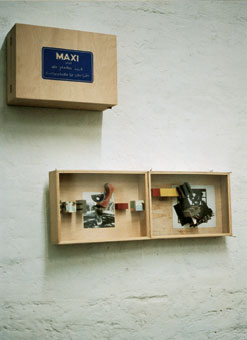
|
Max and Big People
(Art History for Lower Levels)
1990/1991
Wall installation consisting of ten fold-out plywood objects.
Plywood objects: plywood, building bricks, photos, glass, linoprints, incidental material; ten parts, 25 x 36 x 13 cm each.
When open, the boxes display two works of classical modern art each. Based on a view of the work inside the object (photocopy or detail from the Artforum magazine), the artist copied, re-enacted or added to the works with the aid of building bricks (relics of his childhood toys).
|
Maxi und die großen Leute
(Kunstgeschichte für Unterstufen)
1990/1991
Wandinstallation, bestehend aus zehn aufklappbaren Sperrholzobjekten.
Sperrholzobjekte: Sperrholz, Spielklötze, Fotos, Glas, Linoldrucke, Kleinmaterialien; zehnteilig, je 25 x 36 x 13 cm.
Die Kästchen zeigen im geöffneten Zustand je zwei Kunstwerke der Klassischen Moderne. Ausgehend von einer im Objekt angebrachten Ansicht des Werks (Fotokopie oder Ausschnitt der Zeitschrift Artforum) sind die Arbeiten vom Künstler mit Bauklötzen (Relikte des Spielzeugs seiner Kindheit) nachgebaut, nachgestellt oder erweitert.
|
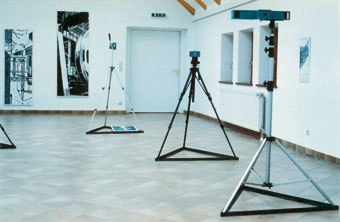
|
Time Spaces
1990/1991
Room installation consisting of copied linocuts, photocopies of illustrations, optical devices on tripods.
Optical devices: plywood boxes built by the artist (black inside, gray outside) of various shapes and sizes, with mirrors inside and mounted on tripods. Pictures: one half linocuts based on photographic motifs of Austria from illustrated books from the 1950s, copied on newspaper and blown up; the other half photocopied and blown-up illustrations (photos, pictures from books); various sizes (from 59 x 25 cm to 173 x 64 cm). Total size: variable.
Only when viewed (observed) using the optical devices do one linocut copy and one photocopy produce a complete subject of the “heroic” themes of Austrian industrialisation arranged around the room: from the Großglockner high Alpine road built in 1935 to such projects as the Danube or Kaprun power plants carried out during the period of reconstruction.
Time Spaces | Kulturzentrum im Weberhaus, Weiz | March 7 to April 7, 1991 | solo exhibition.
|
Zeiträume
1990/1991
Rauminstallation, bestehend aus kopierten Linolschnitten, Fotokopien von Abbildungen, optischen Geräten auf Stativen.
Optische Geräte: Vom Künstler gebaute Sperrholzkästchen (innen schwarz, außen grau) unterschiedlicher Ausformung und Größe, mit Spiegeln im Inneren und auf Stativen montiert. Bilder: Zur einen Hälfte Linolschnitte nach fotografischen Österreich-Motiven aus Bildbänden der 1950er-Jahre, welche auf Zeitungspapier kopiert und stark vergrößert wurden, zur anderen Hälfte fotokopierte und vergrößerte Abbildungen (Fotos, Bilder aus Büchern); unterschiedliche Maße (von 59 x 25 cm bis 173 x 64 cm). Gesamtmaß: variabel.
Erst durch die Betrachtung (Observierung) mittels der optischen Geräte ergeben je eine Linolschnitt-Kopie und eine Foto-Kopie ein vollständiges Sujet der im Raum verteilten „heroischen“ Motive der Industrialisierung Österreichs, von der 1935 errichteten Großglockner-Hochalpenstraße bis hin zu den in der Zeit des Wiederaufbaus realisierten Projekten wie Donaukraftwerke oder Kaprun.
Zeiträume | Kulturzentrum im Weberhaus, Weiz | 7. März bis 7. April 1991 | Einzelausstellung.
> |
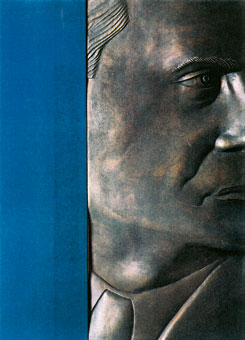
|
National Space
1990
Room installation consisting of a bronzed plaster relief, a free-standing plywood object, and an optical viewing device on a tripod.
Relief: bronzed plaster, plywood, paint, 77 x 58 cm. Object: plywood, paint, 252 x 126 x 6 cm.
The relief shows most of Tito’s right profile, the plywood object – open at the front and back – completes the rest of his face as a negative carved out of the plywood. On the left third of the relief is a monochrome blue bar that represents the flag of former Yugoslavia together with the space between the two objects (white) and the monochrome red bar of the free-standing plywood object. The work was hotly disputed at the exhibition in Celje due to its political statement.
International Weeks of Painting in Celje | Celje, Slovenia | August 15 – September 15, 1990 | exhibition participation | catalog.
|
National Space
1990
Rauminstallation, bestehend aus einem bronzierten Gipsrelief, einem frei stehenden Sperrholzobjekt und einer optischen Betrachtungseinrichtung auf einem Stativ.
Relief: Gips bronziert, Sperrholz, Lack, 77 x 58 cm. Objekt: Sperrholz, Lack, 252 x 126 x 6 cm.
Das Relief zeigt den Großteil von Titos rechter Profilansicht, das Sperrholzobjekt, dessen Vorder- und Rückseite zugänglich sind, ergänzt den Rest des Gesichts als aus dem Sperrholz geschnittenes Negativ. Auf seinem linken Drittel trägt das Relief einen monochrom blauen Längsstreifen, der zusammen mit der Leere zwischen den beiden Objekten (weiß) und dem monochrom roten Streifen des frei stehenden Sperrholzobjekts die Flagge des ehemaligen Jugoslawien ergibt. Die Arbeit war aufgrund ihrer politischen Aussage im Zuge der Ausstellung in Celje heftig umstritten.
Internationale Malerwochen in Celje | Celje, Slowenien | 15. August bis 15. September 1990 | Ausstellungsbeteiligung | Katalog.
|




